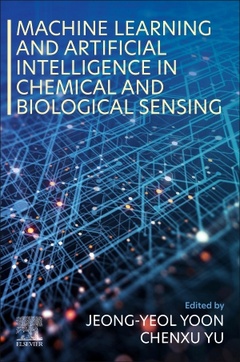Description
Machine Learning and Artificial Intelligence in Chemical and Biological Sensing
Coordinators: Yoon Jeong-Yeol, Yu Chenxu
Language: English
Subjects for Machine Learning and Artificial Intelligence in Chemical...:
272 p. · 15x22.8 cm · Paperback
Description
/li>Contents
/li>Biography
/li>Comment
/li>
Machine Learning and Artificial Intelligence in Chemical and Biological Sensing covers the theoretical background and practical applications of various ML/AI methods toward chemical and biological sensing. No comprehensive reference text has been available previously to cover the wide breadth of this topic. The book's editors have written the first three chapters to firmly introduce the reader to fundamental ML theories that can be used for chemical/biosensing. Subsequent chapters then cover the practical applications with contributions by various experts in the field. Sections show how ML and AI-based techniques can provide solutions for: 1) identifying and quantifying target molecules when specific receptors are unavailable 2) analyzing complex mixtures of target molecules, such as gut microbiome and soil microbiome 3) analyzing high-throughput and high-dimensional data, such as drug screening, molecular interaction, and environmental toxicant analysis, 4) analyzing complex data sets where fingerprinting approach is needed This book is written primarily for upper undergraduate students, graduate students, research staff, and faculty members at teaching and research universities and colleges who are working on chemical sensing, biosensing, analytical chemistry, analytical biochemistry, biomedical imaging, medical diagnostics, environmental monitoring, and agricultural applications.
2. Fundamentals of Machine Learning (ML) and Artificial Intelligence (AI)
3. Use of ML/AI in Chemical Sensors and Biosensors
4. ML-Assisted E-nose and Gas Sensors
5. ML-Assisted FTIR and Raman Spectroscopic Sensing in Agricultural and Food Systems
6. ML-Assisted Surface-Enhanced Raman Spectroscopic Characterization of Biological Systems
7. AI-Assisted Microscopic Imaging Analysis for High Throughput Phenotyping
8. ML-Assisted Lens-Free Imaging
9. ML-Assisted Multispectral and Hyperspectral Imaging
10. AI/ML-Assisted NIR/Optical Biosensing for Plant Phenotyping
11. ML-Assisted Receptor-Free Biosensing
12. ML-Assisted Flow Velocity Analysis in Paper Microfluidics
13. AI/ML Tools for Single Molecule Data Analysis in Biomedicine
14. ML-Assisted Characterization of In Situ Protein Dynamics at Solid-Liquid Interfaces
15. AI-Assisted Microbial Population Dynamics Modeling
16. AI-Assisted All-in-One Sensor System
Chenxu Yu received his Ph.D. in biological systems engineering from University of Wisconsin-Madison, USA in 2003. He then did post-doctoral training at Pennsylvania State University and Purdue University, USA before joined the faculty at Iowa State University, USA in 2007. He has been serving as an editorial board member of seven reputed journals. His research interests are in the areas of bionanotechnology and biosensors, food and bioprocess engineering, spectroscopic imaging and biodiagnostics, environmental monitoring and engineering.
- Presents the first comprehensive reference text on the use of ML and AI for chemical and biological sensing
- Provides a firm grounding in the fundamental theories on ML and AI before covering the practical applications with contributions by various experts in the field
- Includes a wide array of practical applications covered, including: E-nose, Raman, SERS, lens-free imaging, multi/hyperspectral imaging, NIR/optical imaging, receptor-free biosensing, paper microfluidics, single molecule analysis in biomedicine, in situ protein characterization, microbial population dynamics, and all-in-one sensor systems

